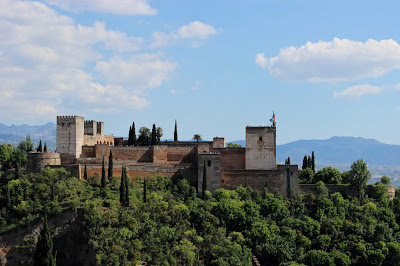Our friends Maggie and Pete have been living there on a
six-month sabbatical, their second one in Granada. Since I was going to be
right next door on my trip to Portugal, I figured I’d fly down to visit them
for a few days. I had been to Spain before, Barcelona and Salamanca, and liked
them both, but neither one prepared me for the magic that is Granada.
Maybe it has something to do with the Mediterranean light
bouncing off the stone buildings,
combined with the layers of history in the Medieval Moorish
neighborhood of the Albayzin,
or the abundance of fountains,
or the majestic Alhambra overlooking the city, framed by the snow-capped Sierra Nevada range.
This is a special place.
Shortly after I arrived, Pete and Maggie led me up the
narrow, winding streets of the Albayzin to a restaurant perched across from the
Alhambra. This modest spot has to have one of the best views in all the world.
Alternating between sips of Ribera (did I mention
that exquisite wines can be had for less than three euros a glass?) and smooth,
garlicky gazpacho, I felt myself start to fall.
On our way back to their apartment, we passed by an ancient
communal bread oven,
walked under balconies made out of tile,
and at one point turned into a small piazza, empty except
for a central fountain and a young man
playing a haunting Spanish guitar.
The next day, Maggie and I started off with a typical
Andalucian breakfast of tostada con
tomate, or bread slathered with fresh tomatoes. It’s served with olive oil,
which you drizzle on top of the bread after pricking it with a fork to help the
oil soak in. Delicioso.
We then set
off to explore the Alhambra, which soars above the city on a high plateau. The
Alhambra’s rustic exterior, beautiful in its own way, doesn’t give any
indication of the magnificent detail to be found within.
I’m not exaggerating when I say that it’s the most
impressive structure that I’ve ever seen. Originally an Islamic palace and
fortress complex dating back to the 13th century, it’s a jewel box
of tile work,
intricately carved plaster, wood, and stone,
serene reflecting pools,
and
sculpted gardens.
When the Moors’ 800 years of rule ended, the Alhambra fell
into the hands of the Spanish monarchy. Although the monarchy renovated and
enlarged the complex to suit their purposes, they fortunately did not
significantly alter much of the architectural detail, thereby preserving its unique
grandeur. It was in one of the
Alhambra’s rooms, the sultan’s throne room, that Isabella gave her approval and
money to Christopher Columbus to embark on his voyage to the “new world.”
It saddens me that the actions of a small number of jihadists
can cause a large number of Americans to fear and shun an entire culture, rich
in history, art, and stunning beauty. As we wandered through the Alhambra, I
was struck by how nature is interwoven throughout— in the gardens and inner courtyards,
in the glimpses of mountains through arching windows,
in the green of the
surrounding forest,
and in the images of the natural world painted on the tiles
and carved into the stone, plaster, and wood.
Even though we were surrounded by
other tourists, the serenity in each space was palpable.
We stopped for a late lunch at a restaurant with an outdoor
terrace overlooking the sultan’s summer palace. Maggie and Pete live about 15
minutes away from us in Vermont and we’ve known them for years, but there’s
something about being with friends in a completely different environment that
reveals a new side of the friendship, broadening and deepening it. Some of my
best memories of various friendships over the years are from times when we were
experiencing a different country together. That combination of familiarity and
exoticism is, to me, one of life’s great pleasures.
Another afternoon, craving more gazpacho, I ordered it again
and this time it came with chopped peppers and cucumbers to stir into the purée.
I’ll be recreating this version of gazpacho in my own kitchen this summer, as
soon as the fresh tomatoes start to roll in.
One day we happened upon the market area, which I always
manage to sniff out in a new place. The offerings here are reflective of the
local cuisine: fresh fish and seafood,
dried peppers,
oranges and fava beans,
and olives, in addition to their oil.
When I flew into Granada, olive trees lined the landscape
surrounding the city for as far as I could see, so it’s no surprise that olive
oil forms the foundation of much of their cuisine.
No trip to Granada would be complete without a tapas crawl.
The locals typically don’t eat dinner until around 10 pm, but they often lead
up to dinner with several hours of drinks and tapas. Here’s how it works: for
every round of drinks you order (soft or otherwise), your table gets one or two
tapas on the house. Sometimes you have a choice in what’s delivered; sometimes
you don’t. Pete and Maggie took me to some of their favorite spots, complete with entertaining staff,
where we
sampled the wines and the accompanying tapas: fried shrimp and calamari, pork
scallopini, braised beef, razor clams with fresh lemon. No need to order dinner
after snacking on the likes of these.
As we strolled home to their apartment through the winding
cobblestone streets, I knew I’d be back. Our next sabbatical is in three years,
and I don’t think it will take much convincing for Chris to be as intrigued as
I am to spend at least part of it in Granada.

































Sheila, seriously - your photos are amazing!! Love this post.
ReplyDeleteThanks, Porter. Granada is a photographer's dream. We may do our next sabbatical there--you have to come visit!
Delete